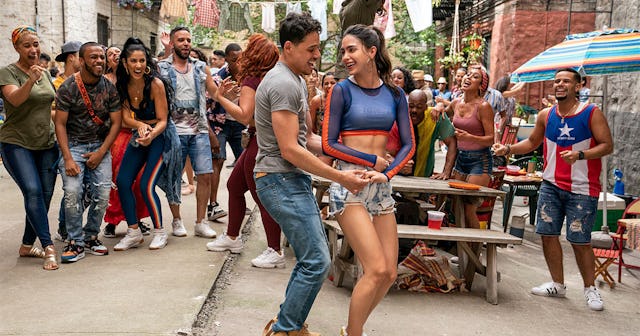I'm Raising Latinx Daughters––Why 'In The Heights' Means So Much To Me

Throughout the years, I have enjoyed sharing many different musicals with my daughters. Though, if I’m being honest, a constant pain point was seeing the same cast over and over again. I don’t literally mean the same cast–but the same white, straight, average-sized, able-bodied people who are always represented.
For example, let’s look at “West Side Story.” How are you going to tell a story about Puerto Rican immigrants and their struggle with racial prejudice by casting white actors and having them wear makeup? Thankfully, Hollywood has come leaps and bounds since the release of the original film, and Steven Spielberg will be righting some of those casting wrongs in an upcoming remake of “West Side Story,” set to be released in December 2021. But in the meantime, if you are looking for an accurate and authentic experience of Latinx pride, the long-awaited moment for “In The Heights” has finally come.
We (my family) came for the energizing music and invigorating dance sequences, but we stayed for the inspirational messages around community and culture. The impact of seeing themselves represented (as Latinas) was incredibly empowering to my daughters.
“In The Heights” has quite the cast of characters. Usnavi (Anthony Ramos) is the owner of his late-parents bodega, Nina (Leslie Grace), a first-generation college student, and Sonny (Gregory Diaz), a dreamer, just to name a few. You see, watching this film with my daughters meant so much more because we know each and every one of these characters. I mean, we don’t actually know the actors who played them (a girl can dream), but we know someone in our real lives who they represent. We followed storyline after storyline of characters whose parents had immigrated to the United States with a dream of giving their children more than they had.
Macall Polay/Warner Bros.
Quite literally, this was their Dad and his parent’s experience. My husband is a first-generation Mexican-American. Their family immigrated from a small village (in the state of Jalisco) from western Mexico in the mid 1980s. It’s one thing to hear your Abuelo and Abuela talk about their history, but to see it play out on a big screen is priceless.
One of the first storylines the movie introduces is Nina and her father, Jimmy (Kevin Rosario). Nina is a first-generation college student at Stanford. She is celebrated by her community as the one who got out. Even though she struggles when she is away because she feels like she doesn’t fit in.
Telling Nina’s story was important to Lin-Manuel Miranda and his co-writer Quiara Alegria Hudes. As NBC reports, Miranda “had to fight movie executives and producers who wanted to rely on worn-out tropes that have disproportionately portrayed Latinos as the help, criminals, or individuals who only live trauma-ridden lives.” And as Miranda recounts in an interview with NBC News,“[we] h… Quiara and I stuck to our guns and stuck to what we felt was important in the storytelling of the show.”
Representation matters. And it matters, even more, to see yourself reflected outside of the traditional roles you are expected to fill. It might not seem like a big deal to people who are not Latinx. I mean, we (white people) see ourselves represented ALL THE DAMN TIME. But for my daughters to see Latinas that look like them and hear a language usually only spoken inside their Abuela’s kitchen — it’s empowering. While their father and I appreciate “In The Heights” for not falling back on stereotypical tropes, our daughters get over-joyed seeing their culture on display. From Spanglish to vibrant dancing, they finally get to their see real-life experiences on the big screen.
Macall Polay/Warner Bros.
Another one of their favorite storylines is Vanessa’s (Melissa Barrera). Vanessa is an aspiring fashion designer who dreams of leaving her job at the salon to pursue fashion. An underlying theme in Vanessa’s journey is that she isn’t really an artist because people like her just–aren’t. Well, at least not until she dresses differently and lives in a neighborhood outside of the Heights. This internal conflict of not fitting the mold of what society says you should or shouldn’t be because of where you come from has GOT TO GO. Unfortunately, this scenario isn’t one that only plays out in a fictional setting.
Research conducted in partnership with Wise Entertainment and the National Association of Latino Independent Producers, and reported in The New York Times, found that “of the 100 top-grossing films each year from 2007 to 2018, only three percent featured Latino actors in lead or co-lead roles.”
When it is estimated that by 2045, 1 in 4 people who live in the United States will be Hispanic, it is woefully clear how underrepresented the Latinx community has been to this point. Thankfully, there are directors and producers like Miranda and Quiara who are willing to tackle this head-on by bringing us these films.
“In The Heights” is a movie we will definitely be adding to our collection. Not only is it an enjoyable film to watch, more importantly, it showcases an incredibly diverse Latinx community. It’s a celebration of Hispanic culture, from Cuba and the Dominican Republic to Mexico and Puerto Rico. “In The Heights” honors and represents the greater Latinx community in a way we do not see often enough. This film is important in so many ways–but in the end, I appreciate it most for the empowering and inspiring message it offers to my daughters.